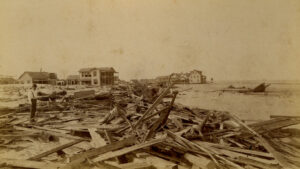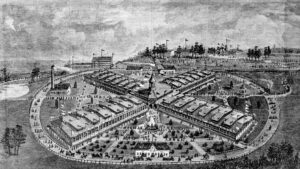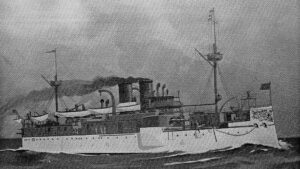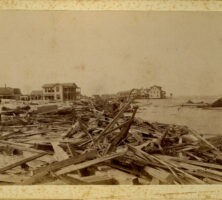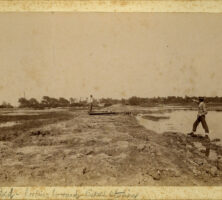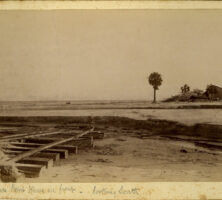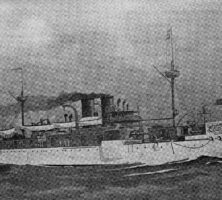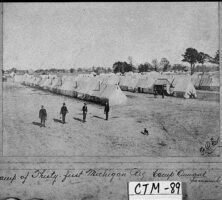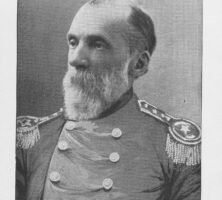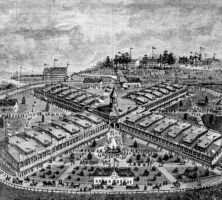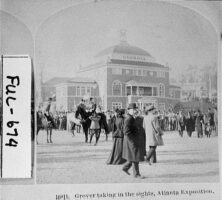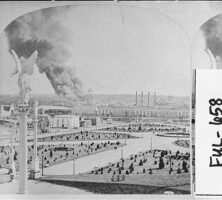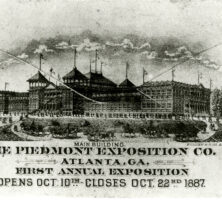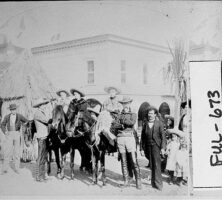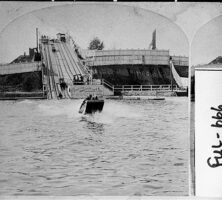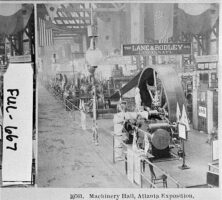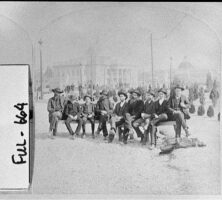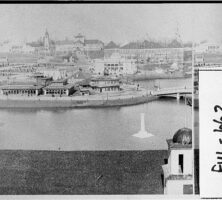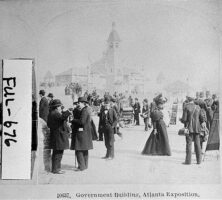The New Georgia Encyclopedia is supported by funding from A More Perfect Union, a special initiative of the National Endowment for the Humanities.
Damaged homes along the beach after the 1893 hurricane hit Tybee. One of the deadliest hurricanes in American history, the storm was the equivalent of a Category 3 hurricane on the modern-day Saffir-Simpson scale.
Courtesy of Georgia Historical Society, Elizabeth B. Pittman Collection on Nichols, Baker, and Mongin Families., #GHS 2536-01-07-11.
The New Georgia Encyclopedia does not hold the copyright for this media resource and can neither grant nor deny permission to republish or reproduce the image online or in print. All requests for permission to publish or reproduce the resource must be submitted to Georgia Historical Society.
Men along a flooded road after the 1893 hurricane hit Tybee. The storm devastated the barrier islands of Georgia and South Carolina, killing over 2,000 people and leaving more than 30,000 homeless.
Courtesy of Georgia Historical Society, Elizabeth B. Pittman Collection on Nichols, Baker, and Mongin Families., #GHS 2536-01-07-03.
The New Georgia Encyclopedia does not hold the copyright for this media resource and can neither grant nor deny permission to republish or reproduce the image online or in print. All requests for permission to publish or reproduce the resource must be submitted to Georgia Historical Society.
Damaged railroad tracks and homes on the beach after 1893 hurricane hit Tybee. Buildings, bridges, and other infrastructure were demolished up and down the Georgia and South Carolina coasts.
Courtesy of Georgia Historical Society, Elizabeth B. Pittman Collection on Nichols, Baker, and Mongin Families., #GHS 2536-01-07-06.
The New Georgia Encyclopedia does not hold the copyright for this media resource and can neither grant nor deny permission to republish or reproduce the image online or in print. All requests for permission to publish or reproduce the resource must be submitted to Georgia Historical Society.
An explosion aboard the American battleship USS Maine in 1898 resulted in the sinking of the ship and the deaths of 266 men. The attack propelled the United States into a military conflict with Spain, which would later be known as the Spanish-American War.
From Pictorial History of Our War with Spain for Cuba's Freedom, by T. White
The New Georgia Encyclopedia does not hold the copyright for this media resource and can neither grant nor deny permission to republish or reproduce the image online or in print. All requests for permission to publish or reproduce the resource must be submitted to the rights holder.
Camping in long rows of tents, soldiers from the Thirty-first Michigan Regiment were stationed at Camp "Onward" in Savannah during the Spanish-American War (1898).
Courtesy of Georgia Archives, Vanishing Georgia, #
ctm089.
The New Georgia Encyclopedia does not hold the copyright for this media resource and can neither grant nor deny permission to republish or reproduce the image online or in print. Requests for permission to publish or reproduce the resource should be submitted to the Georgia Archives.
General Joseph Wheeler, born near Augusta, commanded U.S. volunteers in Cuba during the Spanish-American War. Wheeler also served during the Civil War and the Philippine Insurrection, and authored several books on military and civil subjects. Wheeler County, in central Georgia, is named in his honor.
From The Conflict with Spain and Conquest of the Philippines, by H. F. Keenan
The New Georgia Encyclopedia does not hold the copyright for this media resource and can neither grant nor deny permission to republish or reproduce the image online or in print. All requests for permission to publish or reproduce the resource must be submitted to the rights holder.
The 1881 International Cotton Exposition buildings in Atlanta's Oglethorpe Park consisted of a central building and several wings. The central building was devoted to textile-manufacturing displays while the wings showcased other southern products, including sugar, rice, and tobacco.
Courtesy of Atlanta History Center.
The New Georgia Encyclopedia does not hold the copyright for this media resource and can neither grant nor deny permission to republish or reproduce the image online or in print. Requests for permission to publish or reproduce the resource should be submitted to the Atlanta History Center.
U.S. president Grover Cleveland (foreground) walks past the Georgia Building at the 1887 Piedmont Exposition, held in October at Atlanta's Piedmont Park. More than 50,000 visitors attended the exposition that day.
Courtesy of Georgia Archives, Vanishing Georgia, #
ful0674.
The New Georgia Encyclopedia does not hold the copyright for this media resource and can neither grant nor deny permission to republish or reproduce the image online or in print. Requests for permission to publish or reproduce the resource should be submitted to the Georgia Archives.
Grant Williams, a civil engineer, turned Atlanta's 1887 Piedmont Exposition grounds into a larger venue to accomodate the more ambitious 1895 Cotton States and International Exposition. Williams's plan included twenty-five buildings, a lake, fountains, and statuary.
Courtesy of Georgia Archives, Vanishing Georgia, #
ful0658.
The New Georgia Encyclopedia does not hold the copyright for this media resource and can neither grant nor deny permission to republish or reproduce the image online or in print. Requests for permission to publish or reproduce the resource should be submitted to the Georgia Archives.
This drawing shows the 1887 Piedmont Exposition's main building. Located in Atlanta's Piedmont Park, the structure was 570 feet long, 126 feet wide, and two stories high. The Exposition opened on October 10 to nearly 20,000 visitors.
Courtesy of Atlanta History Center.
The New Georgia Encyclopedia does not hold the copyright for this media resource and can neither grant nor deny permission to republish or reproduce the image online or in print. Requests for permission to publish or reproduce the resource should be submitted to the Atlanta History Center.
A Mexican village display at the 1895 Cotton States and International Exposition, held at Piedmont Park in Atlanta.
Courtesy of Georgia Archives, Vanishing Georgia, #ful0673.
The New Georgia Encyclopedia does not hold the copyright for this media resource and can neither grant nor deny permission to republish or reproduce the image online or in print. Requests for permission to publish or reproduce the resource should be submitted to the Georgia Archives.
Shooting the chutes, an early type of water ride, on Lake Clara Meer during the 1895 Cotton States and International Exposition, held at Piedmont Park in Atlanta.
Courtesy of Georgia Archives, Vanishing Georgia, #
ful0666.
The New Georgia Encyclopedia does not hold the copyright for this media resource and can neither grant nor deny permission to republish or reproduce the image online or in print. Requests for permission to publish or reproduce the resource should be submitted to the Georgia Archives.
Exhibitions in the Machinery Hall at the 1895 Cotton States and International Exposition, held in Piedmont Park in Atlanta. The Lane & Bodley Company of Cincinnati exhibit is in the foreground.
Courtesy of Georgia Archives, Vanishing Georgia, #
ful0667.
The New Georgia Encyclopedia does not hold the copyright for this media resource and can neither grant nor deny permission to republish or reproduce the image online or in print. Requests for permission to publish or reproduce the resource should be submitted to the Georgia Archives.
The Cotton States and International Exposition was the last of three cotton expositions held in Atlanta during the late nineteenth century. Held in Piedmont Park, the exposition presented new technology in a variety of industries and showcased Atlanta as a regional business center.
Courtesy of Georgia Archives, Vanishing Georgia, #
ful0664.
The New Georgia Encyclopedia does not hold the copyright for this media resource and can neither grant nor deny permission to republish or reproduce the image online or in print. Requests for permission to publish or reproduce the resource should be submitted to the Georgia Archives.
View of the north-end grounds and Lake Clara Meer at the 1895 Cotton States Exposition, held in Piedmont Park in Atlanta.
Courtesy of Georgia Archives, Vanishing Georgia, #ful0662.
The New Georgia Encyclopedia does not hold the copyright for this media resource and can neither grant nor deny permission to republish or reproduce the image online or in print. Requests for permission to publish or reproduce the resource should be submitted to the Georgia Archives.
A crowd strolls through Piedmont Park in Atlanta at the 1895 Cotton States and International Exposition. The chime tower and the U.S. government building can be seen in the background.
Courtesy of Georgia Archives, Vanishing Georgia, #
ful0676.
The New Georgia Encyclopedia does not hold the copyright for this media resource and can neither grant nor deny permission to republish or reproduce the image online or in print. Requests for permission to publish or reproduce the resource should be submitted to the Georgia Archives.
